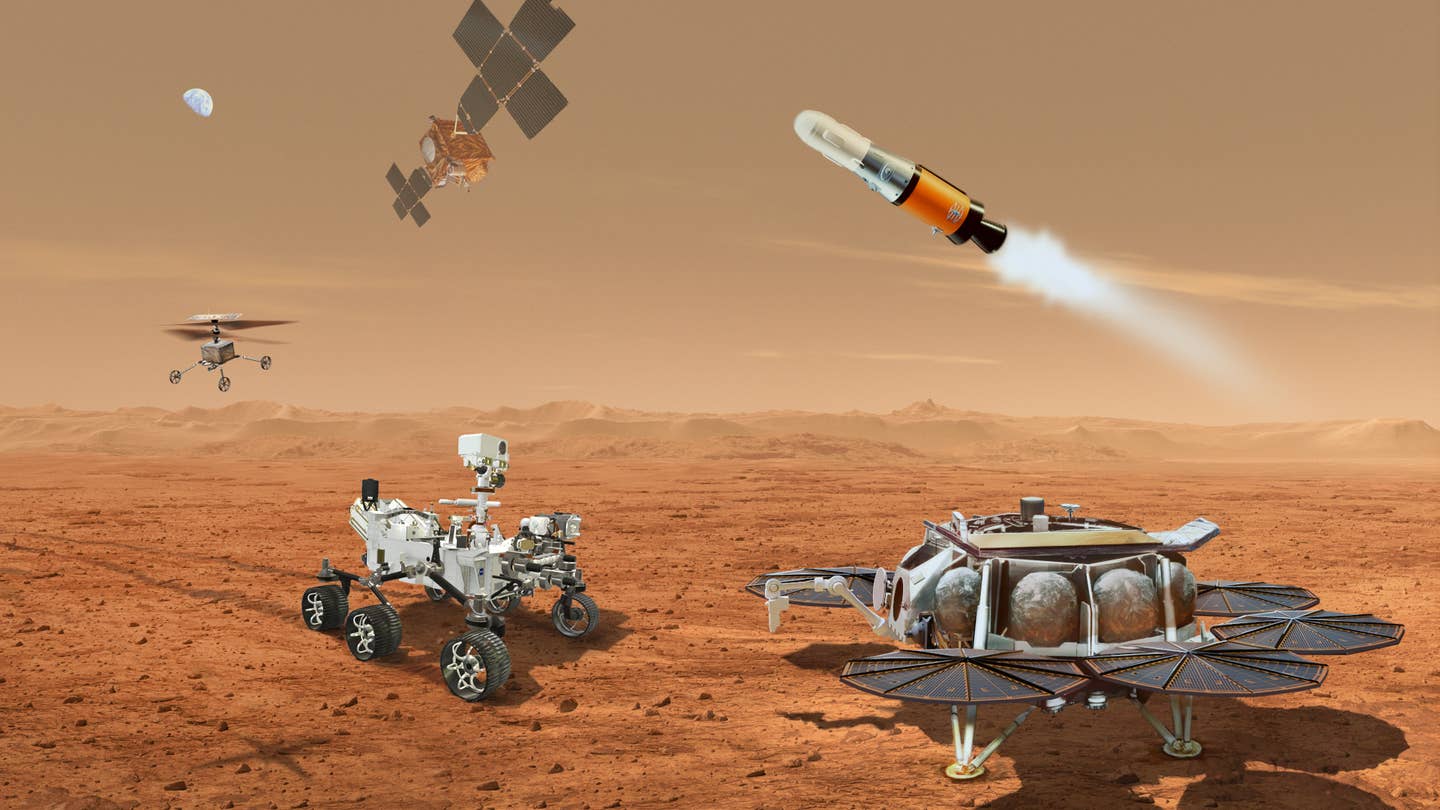NASA Is Asking for Help to Return Samples That Could Uncover Life on Mars
The Mars Sample Return program is a joint NASA-ESA effort, with the goal of uncovering signs of ancient life on the Red Planet.

An artist’s illustration depicts the vehicles NASA initially planned to use to recover samples from its Perseverance Martian rover. [Courtesy: NASA]
NASA Administrator Bill Nelson has shared the space agency’s “revised path forward” for the Mars Sample Return program, a proposed NASA-European Space Agency (ESA) mission to return Martian rock and soil samples to Earth. NASA’s Perseverance rover has been collecting rock and soil samples on the Red Planet since 2021.
The agency is asking “the NASA community,” including its Jet Propulsion Laboratory and other agency centers, to collaborate on “out-of-the-box” designs, using existing technology, that could return the samples.
NASA on Monday released its response to a September 2023 Independent Review Board (IRB) report analyzing Mars Sample Return and its costs. It estimated the mission’s budget at $8 billion to $11 billion, with the high end of that range being more than double previous estimates of $4.4 billion.
Under those constraints, Nelson said, the mission would not return samples until 2040, which he said is “unacceptable.”
“Mars Sample Return will be one of the most complex missions NASA has ever undertaken,” said Nelson. “The bottom line is, an $11 billion budget is too expensive, and a 2040 return date is too far away. Safely landing and collecting the samples, launching a rocket with the samples off another planet—which has never been done before—and safely transporting the samples more than 33 million miles back to Earth is no small task. We need to look outside the box to find a way ahead that is both affordable and returns samples in a reasonable timeframe.”
Nelson also pointed to Congress’ recent budget cuts as a contributing factor in the agency’s current challenges.
The agency’s response to the IRB report includes an “updated mission design with reduced complexity; improved resiliency; risk posture; [and] stronger accountability and coordination.”
It said it will solicit proposals from the industry that could return samples in the 2030s, with responses expected in the fall. These alternative mission designs, NASA said, would reduce cost, risk, and mission complexity. It is unclear exactly what kind of solution the agency is seeking. But it emphasized leveraging existing technologies that do not require large amounts of time and money to develop.
Without more funding, according to NASA, Mars Sample Return could dip into money allocated for projects at the Goddard Space Flight Center, Jet Propulsion Laboratory, and other centers. Projects such as Dragonfly, a mission to Saturn’s largest moon, Titan, could be discontinued, warned Nicola Fox, associate administrator of NASA’s Science Mission Directorate.
Plans for a Mars sample return mission have been proposed by the Jet Propulsion Laboratory since 2001. The samples are expected to help researchers understand the formation and evolution of the solar system and habitable worlds, including our own. They could be used to learn whether there was ancient life on Mars and aid in the search for life elsewhere in the universe.
NASA’s Perseverance rover landed on Mars in 2021 and has been collecting samples since. Originally, the plan was to return them to Earth in 2033 using a rocket, orbiter, and lander. However, the IRB report found that the orbiter and lander likely would not leave the Earth until that year.
A Sample Retrieval Lander would deploy a small rocket to collect samples from Perseverance, using an ESA-provided robotic arm. Sample recovery helicopters—based on the successful Ingenuity autonomous Mars helicopter and also capable of collecting samples—would serve as backup.
A Mars Ascent Vehicle, which would be the first rocket to launch off the Mars surface, would carry samples to the planet’s orbit, where they would be captured by an Earth Return Orbite—also designed by ESA—and brought back to Earth.
The initiative would be the first international, interplanetary mission to return samples from another planet and, according to NASA, would return “the most carefully selected and well-documented set of samples ever delivered from another planet.”
Earlier this year, the space agency marked the 20-year anniversary of its twin Spirit and Opportunity rovers’ arrival on the Martian surface, where they provided the first compelling evidence that the red planet once held water.
NASA’s Curiosity rover is currently surveying a region of the planet thought to have been carved by a river billions of years ago. Its explorations could lead to further discoveries about life on Mars.
Like this story? We think you'll also like the Future of FLYING newsletter sent every Thursday afternoon. Sign up now.

Sign-up for newsletters & special offers!
Get the latest FLYING stories & special offers delivered directly to your inbox






